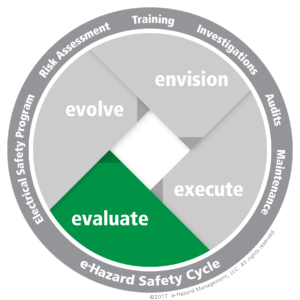Training
Electrical safety training is an OSHA and an NFPA 70E® requirement. In the case of high voltage work, some training is required annually if the skills are not used regularly.
Training has to be documented, but a critical step that is often left off of training is opportunity for interaction with a subject matter expert (SME). OSHA criticized most online and DVD training because this critical part (SME interaction) is most often missing. IF a worker can’t ask questions of an SME, training may not have occurred. Training must be documented and be effective in driving understanding and behavior to meet the OSHA requirements.
So how does your Electrical Safety Training fit into the electrical safety cycle?
Envision: Determine Training Needs
1. Training should be developed by SMEs with a solid track record and expertise in more than just general safety. e-Hazard’s Train the Trainer provides up-to-date NFPA 70E® and other electrical safety training classes ready for a qualified trainer. Accurate training may not be enough to be effective. Cutting and pasting from the OSHA standards or putting an NFPA 70E® standard in front of workers will not assure learning occurs.
2. Training frequency, content, documentation and measurement (testing and auditing) must be part of the plan to be most effective.
3. Don’t substitute more frequent training classes for measurement.
4. Keep the training fresh with the most up-to-date standards and company practices.

5. Customize or add to training packages if your company policies differ. Training planning is just the beginning of that part of the e-Hazard Safety Cycle™ you will keep improving by adding parts and revising parts with best practices on each step of the way.

Execute: Conduct Training
1. Train the workforce at the level they require for their safety. Include electricians, multi-skilled maintenance technicians, electronic technicians, operators, management and even affected workers who are unqualified to do electrical work.
2. Documentation and measurement is critical as one step to judge the effectiveness of the training. Training should generate questions, changes, and even pushback.
Evaluate: Audit Work Practices and Training programs
1. NFPA 70E® requires review of your electrical safety policies at a minimum of every three years.This assures that it meets the current version of that document and the OSHA standards. When this occurs, also review the training materials to assure they are up-to-date with the applicable standards. OSHA, NESC, NFPA 70E®, IEEE, ASTM, CAN/UL S801 or CSA Z462 training or a combination of other standards could be applicable; just be sure you meet them. Meeting the standards is an important part of the e-Hazard Safety Cycle™.


Evolve: Retrain Based on Observations
1.Supervisory work practice audits can include concrete questions to review worker knowledge in practice and by asking. Auditing shows opportunities for improvement before an incident occurs.
If you don’t have a supervisory audit, our 7 Electrical Safety Habits Video purchase comes with our 7 Electrical Safety Habits Supervisory Audit for free. Our auditing class also offers this and more detailed audits.
2. When there is a failure in the system, presented in the form of a near miss, an incident, an internal audit an external audit or a change in a reference standard, this is an opportunity to REVISE.
3. Revise BEFORE a failure. You will not see the failure, but rest assured, continuous improvement and continuous change are here to stay.
Do You Need Electrical Safety Training?
Join thousands of happy customers who have gone through our training.





